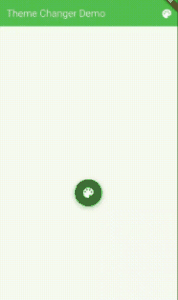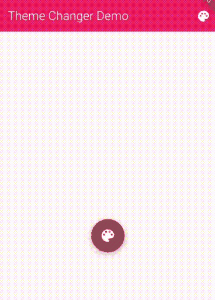flutter_theme_changer_erfan 0.0.5+0  flutter_theme_changer_erfan: ^0.0.5+0 copied to clipboard
flutter_theme_changer_erfan: ^0.0.5+0 copied to clipboard
A Flutter package that allows you to change your app's theme color dynamically with 4 beautiful widgets.
Flutter Dynamic Theme Changer #
A Flutter package that allows you to easily change your app's theme color dynamically at runtime using Riverpod.
It provides both a full theme changer wrapper and four beautiful theme widgets!
☕ Support #
If you find this package helpful, consider supporting my work:
✨ Features #
- 🎨 Dynamic primary color theme switching with Material 3 ColorScheme
- 🧩 Five ready-to-use theme widgets:
ThemeColorPickerWidget: An expandable color picker that can be placed anywhere (Great for floating).ThemeDialogButton: A convenient button that shows colors in a dialog. which is great for all common use cases.CustomColorPickerDialog: A static utility to show a theme picker from any custom widget or UI element.ThemeModeToggle: A simple toggle for switching between light and dark mode.DarkLightModeCustomToggle: An advanced toggle for custom light/dark mode color schemes.
- 🌈 Allow users to pick from customizable color palettes
- 🚀 Built with Flutter Riverpod 2.0 (StateNotifier based)
- 🎯 Simple API and easy integration
- ✍️ Fully customizable if needed
- ✅ Compatible with Flutter 3.24 and Material 3
- 🔄 Optimized performance with background processing
- 💾 Persistent theme preferences across app restarts
- 🧵 Off-main-thread theme generation for smooth UI
🎥 Theme Color Picker Demo #

Above: Animated demo of ThemeColorPickerWidget.
🎥 Theme Dialog Button Demo #

Above: Animated demo of ThemeDialogButton widget.
Getting started #
Add this to your package's pubspec.yaml file:
dependencies:
flutter_theme_changer_erfan: ^0.0.5+0
Then run flutter pub get to install the package.
Or run flutter pub add flutter_theme_changer_erfan in your terminal.
🛠️ How to Use #
Basic Setup #
Wrap your app with ThemeChanger and specify a default color:
void main() {
runApp(
const ProviderScope(
child: ThemeChanger(
title: 'My App',
defaultColor: Colors.purple, // Specify your default theme color this is required!
scaffoldColor: Colors.white, // Optional scaffold background color
child: HomeScreen(),
),
),
);
}
Using ThemeDialogButton #
Add the dialog button to your AppBar for a clean theme selection experience:
AppBar(
title: const Text('My App'),
actions: [
// Add the theme dialog button to your AppBar
ThemeDialogButton(
availableColors: [
Colors.blue,
Colors.red,
Colors.green,
Colors.orange,
Colors.purple,
],
),
],
)
Using ThemeColorPickerWidget #
Place the color picker widget anywhere in your app for a floating theme selection experience:
// For ThemeColorPickerWidget
ThemeColorPickerWidget(
availableColors: [
Colors.teal,
Colors.indigo,
Colors.deepOrange,
Colors.cyan,
Colors.lime,
Colors.amber,
],
)
// For ThemeDialogButton (coming soon)
🎨 Custom Theme Picker Integration #
In addition to the built-in widgets, you can now trigger the theme color picker from any custom UI element using the CustomColorPickerDialog:
Basic Button Example #
ElevatedButton(
onPressed: () => CustomColorPickerDialog.showColorPickerDialog(context),
child: Text('Change Theme'),
)
Icon Button Example #
IconButton(
icon: Icon(Icons.palette),
onPressed: () => CustomColorPickerDialog.showColorPickerDialog(
context,
availableColors: [
Colors.purple,
Colors.orange,
Colors.teal,
Colors.pink,
Colors.indigo,
],
),
tooltip: 'Change Theme',
)
Custom Widget Example #
GestureDetector(
onTap: () => CustomColorPickerDialog.showColorPickerDialog(context),
child: Container(
padding: EdgeInsets.all(12),
decoration: BoxDecoration(
color: Theme.of(context).colorScheme.primary,
borderRadius: BorderRadius.circular(8),
),
child: Row(
mainAxisSize: MainAxisSize.min,
children: [
Icon(
Icons.format_paint,
color: Theme.of(context).colorScheme.onPrimary,
),
SizedBox(width: 8),
Text(
'Custom Theme Selector',
style: TextStyle(
color: Theme.of(context).colorScheme.onPrimary,
),
),
],
),
),
)
Toggle Switch Example #
bool _toggleValue = false;
Switch(
value: _toggleValue,
onChanged: (value) {
setState(() {
_toggleValue = value;
});
if (value) {
CustomColorPickerDialog.showColorPickerDialog(
context,
availableColors: [
Colors.purple,
Colors.orange,
Colors.teal,
Colors.pink,
Colors.indigo,
],
);
}
},
)
From Event Handlers #
void onUserPreferenceChanged() {
CustomColorPickerDialog.showColorPickerDialog(context);
}
This gives you complete flexibility to integrate theme changing functionality with your own UI components and interaction patterns.
Using ThemeModeToggle #
Add a simple light/dark mode toggle to your app:
void main() {
runApp(
const ProviderScope(
child: ThemeChanger(
title: 'My App',
defaultColor: Colors.purple,
child: HomeScreen(),
),
),
);
}
// In your UI:
AppBar(
title: const Text('My App'),
actions: [
// Add the theme mode toggle to your AppBar
const ThemeModeToggle(
showIcon: true,
showText: true,
compact: false,
),
],
)
Using DarkLightModeCustomToggle #
For advanced theming with custom color palettes for light and dark modes:
void main() {
runApp(
const ProviderScope(
child: MyApp(),
),
);
}
class MyApp extends ConsumerStatefulWidget {
const MyApp({super.key});
@override
ConsumerState<MyApp> createState() => _MyAppState();
}
class _MyAppState extends ConsumerState<MyApp> {
@override
void initState() {
super.initState();
_initializeTheme();
}
void _initializeTheme() {
// Define custom colors for light and dark modes
final lightModeColors = {
'background': Colors.white,
'card': Colors.blue.shade50,
'primary': Colors.blue.shade600,
'text': Colors.black87,
};
final darkModeColors = {
'background': Colors.grey.shade900,
'card': Colors.grey.shade800,
'primary': Colors.blue.shade400,
'text': Colors.white,
};
// Initialize custom theme colors
CustomThemeColorPalette.initialize(
ref,
lightModeColors: lightModeColors,
darkModeColors: darkModeColors,
isDarkMode: false, // Default to light mode
syncWithAppTheme: true,
);
}
@override
Widget build(BuildContext context) {
return ThemeChanger(
title: 'Custom Theme Demo',
defaultColor: Colors.blue.shade600,
child: HomeScreen(),
);
}
}
// In your UI:
AppBar(
title: const Text('My App'),
actions: [
// Add the custom theme toggle to your AppBar
Padding(
padding: const EdgeInsets.all(8.0),
child: DarkLightModeCustomToggle(
lightModeColors: {
'background': Colors.white,
'card': Colors.blue.shade50,
'primary': Colors.blue.shade600,
'text': Colors.black87,
},
darkModeColors: {
'background': Colors.grey.shade900,
'card': Colors.grey.shade800,
'primary': Colors.blue.shade400,
'text': Colors.white,
},
syncWithAppTheme: true,
defaultDarkMode: false,
),
),
],
)
How DarkLightModeCustomToggle Works
The DarkLightModeCustomToggle provides a powerful way to implement custom color palettes for both light and dark modes:
-
Named Color Palettes: Define your own color maps with semantic keys like 'background', 'text', 'card', etc.
-
Separate Light/Dark Palettes: Create distinct color sets for light and dark modes that automatically switch when toggled.
-
App Theme Synchronization: When
syncWithAppThemeis set totrue, the toggle will also update the app's main theme. -
Accessing Colors: You can access your custom colors anywhere in your app using:
// Create a color palette reference final colorPalette = CustomThemeColorPalette(ref); // Use it to get colors by name Container( color: colorPalette.getColor('background'), child: Text( 'Hello World', style: TextStyle(color: colorPalette.getColor('text')), ), ) -
Default Mode: Set
defaultDarkModetotrueto start your app in dark mode with the dark palette. -
Custom Icon Colors: Customize the toggle's appearance with
lightModeIconColoranddarkModeIconColor.
This approach gives you complete control over your app's color scheme while maintaining the simplicity of a single toggle for your users.
📦 What's Inside #
| Widget/File | Purpose |
|---|---|
ThemeChanger |
Wraps your app with dynamic theming |
ThemeColorPickerWidget |
Expandable color picker that shows in-place |
ThemeDialogButton |
AppBar button that shows colors in a dialog |
CustomColorPickerDialog |
Static utility to show a theme picker from any widget |
ThemeModeToggle |
Simple toggle for switching between light and dark mode |
DarkLightModeCustomToggle |
Advanced toggle for custom light/dark mode color schemes |
ThemeNotifier + themeProvider |
Riverpod logic for managing theme color |
📲 Example #
A full working example is available inside the /example folder.
To run the example locally:
flutter run --target=example/lib/main.dart
You'll see a floating color button — tap it, pick a color, and the app's theme changes instantly!
✅ All tests passed,including integration tests #
✅ All tests passed, including integration tests #

🙌 Contributing #
Contributions are welcome! Feel free to open issues or submit pull requests if you'd like to help!
🔥 Author #
Erfan Alizada. Developed with ❤️ using Flutter and Riverpod.
Additional information #
- For more examples, check out the example directory
- Report bugs on the issue tracker
- Contribute to the package on GitHub
📄 License #
This project is licensed under the GNU General Public License v3.0. See the LICENSE file for more details.
🔍 Performance Considerations #
This package is optimized for performance with:
- Background processing for theme generation using isolates
- Efficient state management with Riverpod
- Minimal rebuilds when changing themes
- Immediate UI feedback with optimized theme generation
For apps concerned with performance, you can monitor theme changes:
void main() {
WidgetsFlutterBinding.ensureInitialized();
// Add performance monitoring
final observer = PerformanceObserver();
WidgetsBinding.instance.addObserver(observer);
runApp(const ProviderScope(child: MyApp()));
}
📱 Material 3 Support #
This package fully supports Material 3, which is the default in Flutter 3.24+. Key features include:
- Uses
ColorScheme.fromSeedfor harmonious color generation - Properly handles Material 3 theme properties
- Supports the new Material 3 color system
- Adapts to both light and dark themes
The theme picker widgets automatically adapt to your app's Material version and provide a consistent experience.
🔄 Theme Persistence #
Themes are automatically saved to SharedPreferences and restored when the app restarts:
- User theme preferences persist across app sessions
- Fast loading with optimized storage
- Fallback to default theme when no saved preference exists
🧵 Advanced Usage #
Custom Theme Generation #
You can customize how themes are generated by extending the ThemeNotifier:
class CustomThemeNotifier extends ThemeNotifier {
@override
Future<void> updateThemeOffMainThread(Color primaryColor) async {
// Your custom theme generation logic
super.updateThemeOffMainThread(primaryColor);
}
}
// Register your custom provider
final customThemeProvider = StateNotifierProvider<CustomThemeNotifier, ThemeData>((ref) {
return CustomThemeNotifier();
});
Performance Monitoring #
The package includes built-in performance logging that you can use to monitor theme generation times:
import 'dart:developer' as developer;
void main() {
// Enable detailed logging
developer.log('Theme generation performance monitoring enabled', name: 'performance');
runApp(const ProviderScope(child: MyApp()));
}
📊 Technical Details #
- Uses isolates for off-main-thread theme generation
- Implements optimized color calculations
- Leverages Flutter's Material 3 design system
- Provides immediate visual feedback while processing complex themes
🔄 Widget Compatibility Guide #
Here's a guide on which widgets can be combined and which should be used separately:
Compatible Combinations #
✅ ThemeColorPickerWidget + ThemeDialogButton
- These can work well together as they both use the same theme provider. You might use the dialog in the AppBar and the picker widget elsewhere in your UI.
✅ ThemeColorPickerWidget + ThemeModeToggle
- These work well together as they control different aspects: one changes the color palette, the other toggles between light/dark mode.
✅ ThemeDialogButton + ThemeModeToggle
- Similar to above, these control different aspects of theming and can be used together.
✅ CustomColorPickerDialog + ThemeModeToggle
- The dialog can be triggered from custom UI while the toggle handles light/dark mode.
Incompatible Combinations #
❌ ThemeModeToggle + DarkLightModeCustomToggle
- Both control light/dark mode switching but in different ways. Using both will cause conflicts.
❌ DarkLightModeCustomToggle + Any color picker widget
- The custom toggle implements its own color palette system that may conflict with the standard color pickers.
Recommended Setups #
-
Basic Theme Control:
ThemeDialogButtonin the AppBarThemeModeTogglein the AppBar or settings screen
-
Advanced Theme Control:
ThemeColorPickerWidgetas a floating widgetThemeDialogButtonin the AppBarThemeModeTogglein the AppBar or settings screen
-
Custom Theme Control:
CustomColorPickerDialogtriggered from custom UI elementsThemeModeTogglefor light/dark switching
-
Fully Custom Theme System:
DarkLightModeCustomTogglealone, with custom color palettes for both modes
